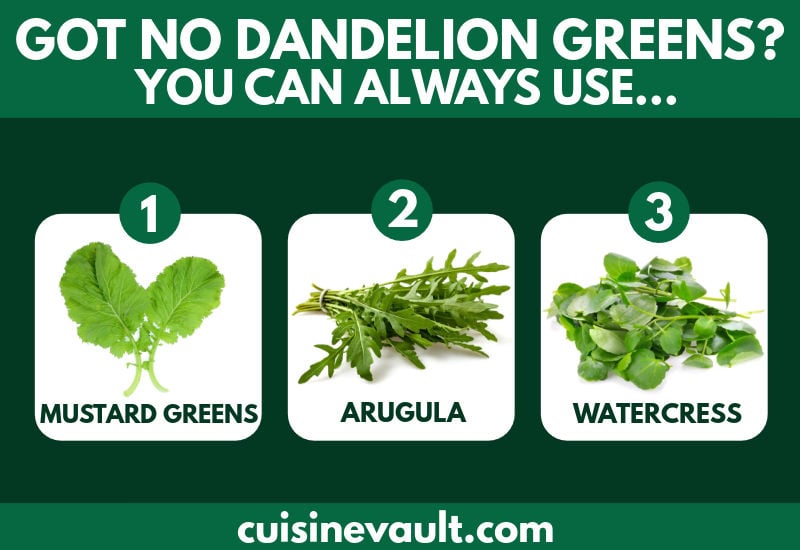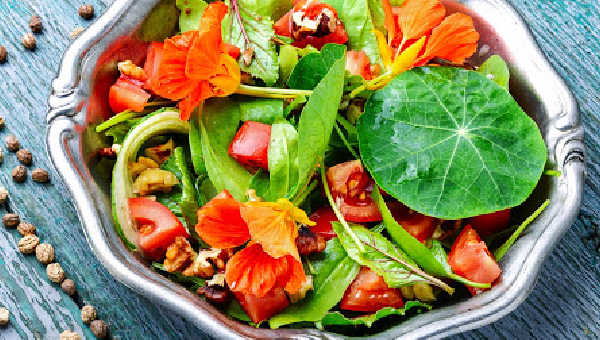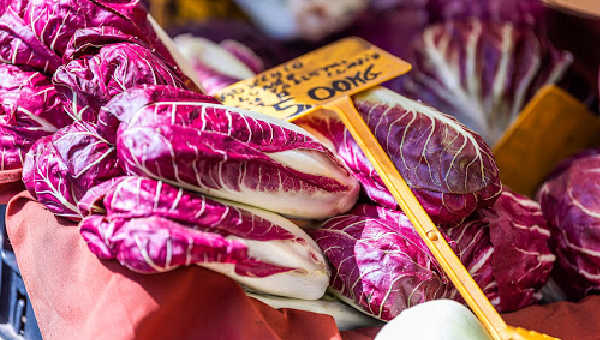Dandelion greens are the green leaves harvested from the plant before the yellow flowers develop. They taste bitter and earthy with a similar flavor to chicory. Picked early, the leaves are tender with less bitterness; they are ideal for salads or sautéing. Older greens are best cooked to tame the bite.
Dandelion greens are relatively easy to find growing wild in most parts of the world. However, it's unlikely you'll find them in any store, especially mainstream supermarkets. If you can't get your hands on any or you want something that tastes a little different, then keep reading. We’re about to provide a useful list of substitutes for dandelion greens.
Table of Contents
What can I use to replace dandelion greens in a recipe?
The best dandelion green substitutes are mustard greens, arugula, or baby spinach. Although a little different in flavor, they’ll slip into any recipe using the original ingredient, whether it’s a raw or cooked dish.
1. Mustard greens
Mustard greens have a peppery, pungent flavor with a fibrous texture. The raw leaves have a strong taste of wasabi and mustard, but cooking will reduce its strength.
Although mustard greens are a little different with their spicy mix of flavors, they will still taste delicious in any recipe that calls for dandelion greens. As a bonus, you get much more vitamin A, C, and K by choosing this alternative.
Finding mustard greens can be difficult in stores so you may want to consider growing them in your garden for a ready supply next time they’re needed.
You can check out our article on mustard green substitutes to learn more about this vegetable.
2. Arugula
Arugula is also known as rocket and is a popular salad green that has a slightly peppery, bitter taste. For garden and bean salads that call for dandelion greens, arugula is a great choice. The leaves aren't as bitter and will appeal to fussy eaters.
Arugula is a more delicate ingredient and doesn't handle cooking well. If you must use it in a cooked dish, then add it at the very end.
3. Watercress
Watercress is another peppery, leafy vegetable that is relatively easy to find in supermarkets. It is a versatile ingredient that can be used raw in sandwiches, processed into pesto, or as a garnish.
The leaves are also suitable for cooking and can be used in soups and stews or sautéed on their own with a splash of olive oil and seasoning.
 4. Spinach
4. Spinach
Baby spinach leaves are crunchy and sweet, without any bitter or earthy flavor. They are a much milder option than dandelion greens and are popular in the salad section of supermarkets.
Spinach can be used in any recipe that calls for raw dandelion greens and is also excellent cooked. Add to stir-fries, casseroles, or use them for your next saag paneer.
Tip: adding a liberal sprinkle of fresh ground pepper will help your spinach leaves taste more like dandelion greens.
5. Curly endive
Curly endive is also known as frisée or chicory. The leaves are commonly used in salads to add a slightly bitter taste to the dish. They can also be grilled or roasted. If you buy the whole vegetable then keep in mind that the inner leaves are more delicate and have a sweeter, milder flavor.
The leaves make a handy alternative to dandelion greens. They are easier to find at the store and are just as versatile in recipes.
6. Escarole
Escarole has green leaves which have a subtle bitter flavor. This vegetable is another good option for people who want milder-tasting food. Use the leaves in salads or cook them as a healthy addition to stews and soups.
7. Nasturtium leaves
 While nasturtium leaves will bring bitterness to a dish, they will also add a tangy, sweet flavor. The leaves are excellent for replacing dandelion greens although you will get a different tasting meal. They’re a great option for people that don't enjoy the original ingredient and want something a little different.
While nasturtium leaves will bring bitterness to a dish, they will also add a tangy, sweet flavor. The leaves are excellent for replacing dandelion greens although you will get a different tasting meal. They’re a great option for people that don't enjoy the original ingredient and want something a little different.
The biggest problem with nasturtium leaves is finding them. Although they’re easy to grow, they are usually only available at specialty stores and some food markets.
8. Kale
Kale is a commonly found vegetable that has a bitter, peppery bite. In recent years it has gained a lot of popularity as a superfood, packed with nutritional goodness.
Some people may find the leaves pack too much flavor when eaten raw. Keep this in mind if you’re making sandwiches or a salad.
9. Rapini
Rapini is a part of the turnip family, commonly used in Italian and Chinese cooking. Unless it is picked young, the leaves will taste intensely bitter.
We recommend this substitute for people who love bitter food. It is also an excellent side dish for balancing out heavy meat dishes like roast pork.
Find out more about the rapini's taste here.
10. Radicchio
Radicchio is a vegetable that has spicy and bitter leaves. It is perfect for adding to uncooked dishes and can also handle high heat cooking as well as slow cooking.
 The biggest difference between radicchio and dandelion greens is the appearance. You'll notice that radicchio has red leaves with white veins running through them. They look delicious sliced and added to coleslaw.
The biggest difference between radicchio and dandelion greens is the appearance. You'll notice that radicchio has red leaves with white veins running through them. They look delicious sliced and added to coleslaw.
11. Collard greens
Choose collard greens as another backup vegetable that is bitter, but less so than dandelion greens. They also aren’t as earthy. Like spinach and escarole, collard greens are a milder option.
Related reading
How can I replace epazote in cooking?
What are some good fenugreek replacements?
What are the best purslane substitutes for your next dish?
Summing up
Although dandelion greens grow like weeds, they are edible and provide excellent health benefits. If foraging for food isn’t up your alley, then it's easy to replace them in any recipe. Try mustard greens, arugula, or watercress as your best options. Each one has comparable taste, similar culinary uses, and they’re easy to buy in store.
Have you ever tried dandelion greens? What did you think of their taste?

Leave a Reply